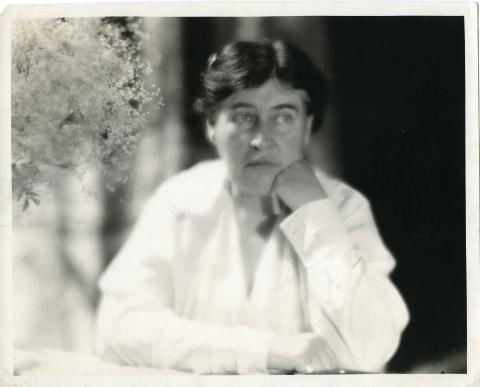Willa Cather Biography
"Miss Cather is Nebraska's foremost citizen," wrote author and Nobel Prize-winner Sinclair Lewis. "The United States knows Nebraska because of Willa Cather's books."
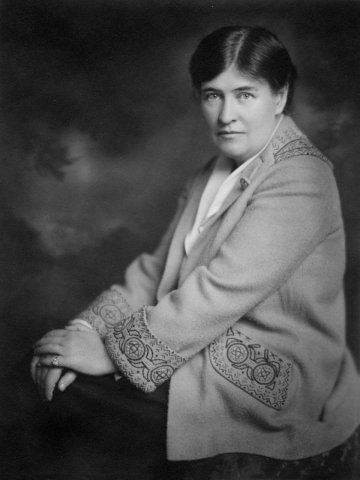
Today Willa Cather is one of the most important American novelists of the first half of the twentieth century. Seen as a regional writer for decades after her passing in 1947, critics and commentators have increasingly identified Cather as among the most significant canonical American writers, one to be counted with the greats in a period characterized by singularities. When Philip Roth died in 2018, New Yorker editor David Remnick held that “he was in competition with the best in American fiction—with Melville, James, Wharton, Hemingway, Faulkner, Cather, Ellison, Bellow, Morrison.” Yes, though Cather deserves to precede Hemingway on this list.
Concluding her fine study of Willa Cather's fiction After the World Broke in Two, the late Merrill Maguire Skaggs asserted that the author "whose portrait emerges from this arrangement of her facts is complex and brilliant," and that "she knows at all points what she is doing. Above all else, she is self conscious" (187). Writing this concluding assessment in the late-1980s, Skaggs knew that beyond her own readings that there existed a growing body of evidence to support such a claim: Sharon O'Brien's influential psychobiography Willa Cather: The Emerging Voice and James Woodress's extended Willa Cather: A Literary Life had each appeared in 1987; about that time too the era’s leading Cather critic, the late Susan J. Rosowski, published a review essay focused on nine new Cather-related volumes in a special issue of Modern Fiction Studies on Cather's work.
This critical interest in Cather as one of the leading figures of American literary Modernism has only increased in the years since. The multi-volume Willa Cather Scholarly Edition (thirteen volumes of its projected fifteen in print) has established true texts for her works and, through each volume’s extensive apparatus, established the making of and biographical contexts of each volume. Complementing the scholarly editions has been Cather Studies, gatherings of critical essays by various hands, now in its sixteenth volume. Both of these series have been published by the University of Nebraska Press. The Willa Cather Review, a well-illustrated analytical periodical that reaches a broad audience beyond academy, is published three times a year by the National Willa Cather Center in Red Cloud. The MLA International Bibliography lists almost 1300 publications on Cather and her works appearing since 2000, and numerous critical monographs have been published which have changed just how Cather is seen and understood. Two of the most prominent recent volumes are Janis P. Stout’s Cather Among the Moderns (2019) and Melissa J. Homestead’s The Only Wonderful Things: The Creative Partnership of Willa Cather and Edith Lewis (2021). Debates among close readers of Cather show no sign of abating any time soon.
Beyond such publication, seminars and symposia focused on Cather are frequent. The National Willa Cather Center each June sponsors a thematic spring conference—the theme of the 2023 iteration was “Complex and Brilliant: Cather at 150,” reflecting the sesquicentennial of Cather birth in 1873. Throughout 2023 too, it has sponsored celebratory Cather 150 events held all over the country—Los Angeles, New York, Pittsburgh, among many other locations. Beginning in the 1980s, International Willa Cather Seminars have been held in locations important to Cather and to her works. The most recent one, in 2023, was held in New York City—her residence from 1906 to 1947—but seminars have also been held in Nebraska, Quebec City (with a pre-trip to Grand Manan Island, New Brunswick), Virginia, Vermont, France (Paris and Avignon), Massachusetts, Chicago, Arizona, and Pittsburgh.
Driving these discussions during the past decade has been the new and ready availability of Cather’s own letters to researchers. These letters are held in archives throughout the country and the world and, until recently direct quotation from them—as opposed to paraphrase—was precluded by a proviso in Cather’s will. But The Selected Letters of Willa Cather (2013), edited by Andrew Jewell and Janis Stout, was published by Alfred A. Knopf and its contents have been combined and extended into The Complete Letters of Willa Cather, an online resource sponsored by the Willa Cather Archive (cather.unl.edu) at the University of Nebraska--Lincoln. Truly, the availability of Cather’s letters has transformed Cather studies. For example, a new Cather biography, Benjamin Taylor’s Chasing Bright Medusas: A Life of Willa Cather (2023) shows this abundantly—it positive abounds with apt and pointed quotations from and references to Cather’s own letters.
Thus without question, the complex brilliance Skaggs saw in Cather during the late 1980s is now a critical consensus and, expanded exponentially in the years since through the availability of her letters. More to the point, this view has been borne of Cather's fiction itself. As Skaggs also maintained, Cather "fashioned fictions of such intricacy and resonating depth that all of them-even the meanest-are still astonishing to read and explore today" (187).
While the reading and understanding of Cather's twelve novels and various other works are the primary attraction, in many ways Willa Cather the person looms large in the critical interest her works have drawn. More than her contemporaries and those figures from the generation which succeeded hers—most especially Faulkner, Fitzgerald, and Hemingway—Cather's fiction creates a personal intimacy between writer and reader which both creates a deep bond and feels authentic, special. This bond is borne of Cather's ability to create on her pages intimate portraits of characters understood in relation to their personal and cultural places. Most often such places owe to Cather's own best place, Red Cloud, Nebraska, such as in her novels of prairie pioneering, O Pioneers! and My Ántonia, but there are a succession of other places found there too: the desert southwest of The Song of the Lark, The Professor's House, and Death Comes for the Archbishop; the tiny enclave of French culture that was Quebec City at the end of the seventeenth century in Shadows on the Rock; and the cultural intricacies of her own birthplace, rural northern Virginia, in Sapphira and the Slave Girl. In the mid-1930s, having returned to Nebraska from Quebec in her penultimate novel, Lucy Gayheart, Cather offers a description of a character which is revelatory of the accomplishments of her own art and, more than that, of herself as a person. The character in question is the book's antagonist, Clement Sebastian, who "had missed the deepest of all companionship, a relation with the earth itself, with a countryside and a people. That relationship, he knew, cannot be gone after and found; it must be long and deliberate, unconscious. It must, indeed, be a way of living" (78).
The Early Years, 1873-1890
Cather was born in Back Creek Valley, Virginia, on December 7, 1873, the eldest of an eventual seven children raised by Charles and Mary Virginia Cather. Cathers had been in the area since the 1700s, and Back Creek, near Winchester west of Washington, was a place deeply affected by the Civil War. It was a border area, one of the counties in Virginia adjacent to the new state of West Virginia, and the contending armies had vied for control there (Winchester shifted between sides multiple times). The Cathers, who had a sheep farm, were sympathetic to the Union and some of Cather's relations were officials of the reconstruction. Emotions ran deep and the effects of the tumult were slow healing.
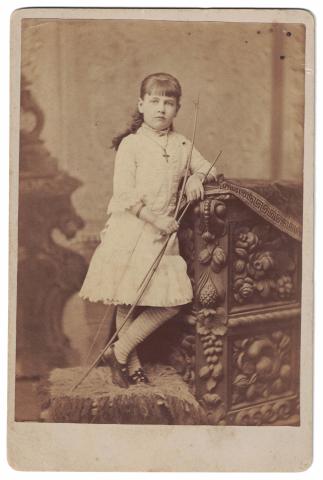
In this place Cather's first litmus years were impressed with memories of rural Virginia and of the deep culture of the South while the war's discord, still near at hand when Cather lived there, remained a great fact. This, the place she started out from and eventually returned to in her last novel, Sapphira and the Slave Girl, gave her memories and imaginative effects which she carried throughout her life. They embody her own repeated "relation with the earth itself." Probably owing to the ongoing frictions caused by the war, when Willa was nine years old, Charles and Mary Virginia decided to leave Back Creek for Webster County, Nebraska, northwest of Red Cloud. In April 1883, Cather moved with her extended family—mother, father, three siblings, her maternal grandmother Rachel Boak and two of her grandchildren, and the family's hired girl Margie Anderson and her brother Enoch—to Nebraska. There they joined Cather's paternal grandparents, William and Caroline, and her Uncle George and Aunt Franc, who were already homesteading a district known locally as Catherton.
Cather alighted with her family at the Red Cloud train depot and drove the twelve miles by team and wagon into the country. The family then stopped at the home of Cather's grandparents, where they would live for the next sixteen months. Cather's first impressions of the prairie filled her with awe and fear, as she told a newspaper interviewer in 1913:
We drove out from Red Cloud to my grandfather's homestead one day in April. I was sitting on the hay in the bottom of a Studebaker wagon, holding on to the side of the wagon to steady myself—the roads were most faint trails over the bunch grass in those days. The land was open range and there was almost no fencing. As we drove further and further out into the country, I felt a good deal as if we had come to the end of everything—it was a kind of erasure of personality.
I would not know how much a child's life is bound up in the woods and hills and meadows around it, if I had not been jerked away from all these and thrown out into a country as bare as a piece of sheet iron. I had heard my father say you had to show grit in a new country, and I would have got on pretty well during that ride if it had not been for the larks. Every now and then one flew up and sang a few splendid notes and dropped down into the grass again. That reminded me of something—I don't know what, but my one purpose in life just then was not to cry, and every time they did it, I thought I should go under. (Bohkle 9-10)
When she offered this description, Cather had just published O Pioneers!, her first and far more literary novel focused on prairie pioneering. It would be followed in 1918 with the more personal My Ántonia where the narrative proper begins with the very autobiographical experience Cather described. Transposed to Jim Burden, the narrator, these memories inform his first impressions of the Nebraska prairie—he is newly orphaned, removed to this place which seems otherworldly: "I had never before looked up at the sky where there was not a familiar mountain ridge against it. But this was the complete dome of heaven, all there was of it. . . . Between that earth and that sky I felt erased, blotted out" (My Ántonia 7-8).
Cather's removal from the settled and deeply felt culture of postwar rural northern Virginia to the pioneering prairie of the Nebraska Divide—a sensitive child at a critical age—was in many ways her making as an artist. Dropped into such a place at such a time, naturally curious, young Cather made the very most of it during her first year in Nebraska. As she made clear repeatedly after O Pioneers! was published, she had been afforded a rare opportunity for an incipient writer: though sparsely settled, the Divide between the Republican and Blue rivers offered her multiple opportunities to meet and gather information from immigrants and other pioneers who spoke different languages and engaged in other cultural practices. The young Cather, whom Joan Acocella has rightly described as "one of those genius children—a show-off, an explosion, a pest" (Politics 7), listened to these stories and stockpiled the details, not knowing the use she would later put them too in some of her novels.
During her time on the Divide, Cather attended a one-room school house, but Charles Cather was not suited to be a prairie farmer so after about a year and a half in Catherton the family moved into Red Cloud—a decision made in part so the children could receive a better education at the town's school. At that time, Red Cloud was a division point on the Burlington railroad and so sustained a population of about 1,800. Eight passenger trains and several grain trains passed through Red Cloud daily, and a horse-drawn streetcar transferred passengers to and from the depot south of town. The Red Cloud Opera House, now restored and the offices and performance space of the National Willa Cather Center, was built in 1885 and was the cultural center of the town—it hosted concerts, speakers, and performers. There the young Willa Cather developed her love for the stage, for musical performance, and for artistry of all sorts.
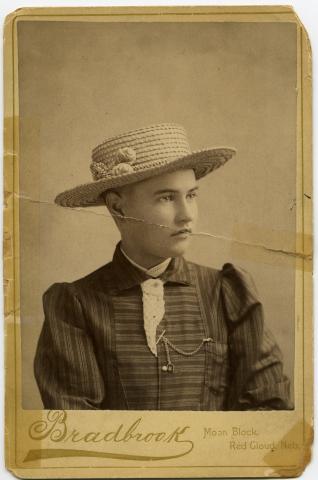
When they moved to Red Cloud, Cather's parents rented a house on Third and Cedar streets, and Charles Cather opened an office to deal in real estate, insurance, and loans. Their neighbors, an educated Jewish couple name Wiener, spoke French and German and gave Willa access to their personal library. Mrs. Wiener read her French novels and interpreted them as she went along. Cather's other neighbors, the Miners, quickly became her closest friends. Cather heard serious music for the first time in the Miner house; she would often listen to Mrs. Miner—a talented musician—play the piano. Both the Wieners and the Miners served as prototypes for figures in Cather's fiction—the former appear as the Rosens in one of her best short stories "Old Mrs. Harris," and in My Ántonia Cather recreated the atmosphere in the Miner home by her creation of the Harlings, whose home draws Jim by its activities and society. In the novel Jim is also drawn to the Harlings by the presence of Ántonia Shimerda. Growing up in Red Cloud, Cather had also met the Miner's hired girl, Annie Sadilek. Sadilek, an immigrant from Bohemia, had moved to Nebraska with her family where they had initially lived in a dugout house before moving into town; her father had committed suicide. That suicide would become the basis for Cather's first published story, "Peter," and Annie herself would later serve as central to My Ántonia.
As Cather grew into adolescence in Red Cloud, she continued to explore the countryside, meet new people, and remained an active presence in the town. As one of "those genius children," it was clear to all that the Cathers' oldest daughter was going somewhere, that she had a future. Cather had befriended the local doctors, so initially she seemed to be defying norms by heading toward medicine. She cropped her hair short, referred to herself as "Willie," William, or "Wm" Cather, M.D., and adopted a generally male form of dress. In 1890, at the age of sixteen, Cather graduated from Red Cloud high school along with two others, both boys. Each delivered a graduation speech on the stage of the Opera House. Cather's—published in the Red Cloud Chief—was an answer to local people who had evidently been critical of her interests in biology and medicine. James Woodress, who published the whole text, called it "a ringing defense of scientific inquiry" which "ranges from the dawn of history to the present moment" (60). Ironically, the Chief foresaw great accomplishment for the two boys but was silent on Cather's prospects.
The University of Nebraska, 1890-1895
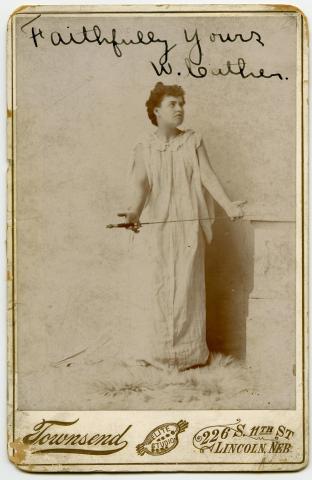
Shortly after graduating from high school, Cather left for the University of Nebraska in Lincoln where she hoped to become a doctor. That goal changed when her first English professor submitted her essay on Carlyle to the Lincoln Journal and the paper published it—Cather later recalled it was at that moment she decided to become a writer.
Cather spent five years at the university. (Her first year was spent in the university's preparatory school fulfilling matriculation requirements.) Having just arrived from a small town, she took full advantage of the capital's opportunities—cultural, social, and especially literary. She joined the student newspaper, the Hesperian, and later became its managing editor. She also served as literary editor of the Sombrero (1894), her class yearbook. Beyond such work, Cather began a career as a journalist by writing extensively for both the Lincoln Courier and the Nebraska State Journal, writing a column for the first and reviewing extensively for the second. Although she did this in part for the money it paid—she supported herself during 1893–95—Cather established herself as a remarkable presence in the intellectual world of both the university and Lincoln while she was earning her degree.
That her nonfiction writings from this period make up three large volumes—The World and The Parish (two volumes) and The Kingdom of Art—is indicative of the tremendous drive the young Cather evinced. Viola Roseboro', later a colleague of Cather's at McClure's and probably the person who brought Cather to the attention of S. S. McClure, once remarked that "if Willa Cather had been a scrub-woman, she would have scrubbed much harder than other scrub-women" (Lewis 30).
Journalist and Teacher, Writer and Poet, 1895-1912
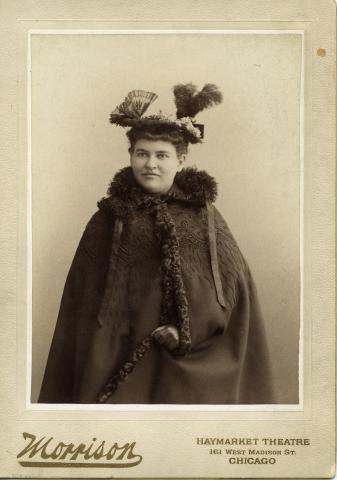
Following her graduation in June 1895, Cather returned to Red Cloud for a year, before securing, through connections she had made while reviewing in Lincoln, a position running the Home Monthly magazine in Pittsburgh. Then an imitator of the Ladies Home Journal, the Home Monthly was not much of a publication but it was an important first step for Cather—she wrote much of the material it published herself, fiction, nonfiction, and poetry, commissioned artwork, managed its layout and printing. More than work, in Pittsburgh—then a major city of some 400,000—Cather took full advantage of the city's cultural scene. She attended live performances, wrote criticism for concerts and the dramatic arts for Pittsburgh Daily Leader, sent some of the same material back to the Nebraska State Journal, and pursued an active social life. In many ways, Cather's time in Pittsburgh was her making as a professional, for there she established her own base and her own connections, developing herself as a journalist and a writer of fiction, branching out. After her first year there she left the Home Monthly to work as the telegraph editor on the Pittsburgh Daily Leader; she stayed there and with other journalism until early 1901, when she accepted a high school teaching position in Pittsburgh, later moving across the river to Allegheny, where she taught until she moved to New York in 1906.
The most notable friendship Cather made in Pittsburgh was with Isabelle McClung, the daughter of a prominent Pittsburgh judge. Without question the closest emotional attachment Cather had outside of her immediate family, Isabelle inspired, encouraged and fostered Cather's writing, bringing her into the McClung home in one of the best Pittsburgh neighborhoods (nearby neighbors were the Carnegies, the Fricks) and providing a quiet space where Cather could write. The two set off in 1902 on Cather's first trip to Europe—to Britain and France; there they met Dorothy Canfield, a friend of Cather's from Lincoln who would become a prominent writer herself, and the three made a well-known visit with A. E. Housman, then a poet Cather much admired.
While still writing fiction, Cather was then concentrating on poetry—her first book, April Twilights, appeared from a vanity press in 1903. It was well-reviewed and, along with the stories she had been publishing and the connections she had made, probably played some role in Cather's coming to the attention of S. S. McClure, then one of America's best-known editors. His McClure's Magazine had become synonymous with the exposure and eradication of social ills—"muckraking"—and it was also the leading monthly publishing fiction, poetry, and other items of cultural interest. Having heard of Cather from various sources, McClure summoned her to New York for an interview in May 1903. This experience transformed Cather's situation since, as was his practice, McClure promised her a great deal in that interview; he would publish her stories in his magazine—some she had previously submitted had been rejected—and also in book form. More than that, he would watch and help her career. McClure was as good as his word, since Cather's second book, The Troll Garden, a collection of stories, appeared from McClure, Philips in 1905.
Yet the most momentous result of Cather's first interview with McClure was his decision, when his magazine was having difficulties with its staff in 1906, to offer her a job and bring her to New York. She accepted, and this was a decision that transformed her career. Building upon her solid foundation as an energetic journalist in Lincoln and Pittsburgh, drawing upon her own then still nascent accomplishments as a poet and fiction writer, Cather was placed in 1906 at the nexus of professional literary life in the United States. Along with the magazine's muckraking—a dimension of its offerings which, although some have argued so, Cather never eschewed—McClure and McClure's had relations at the time with most prominent writers writing in English. When she met McClure in 1903, Cather also met his family and Mrs. Robert Louis Stevenson, who was visiting the McClures. Among his prominent authors were Joseph Conrad and Henry James, and the magazine was publishing the early poetry of William Butler Yeats. As such a situation confirms, at McClure's Cather herself became one of the most influential editors in America, for by 1908 she was its Managing Editor and deep into its myriad details.
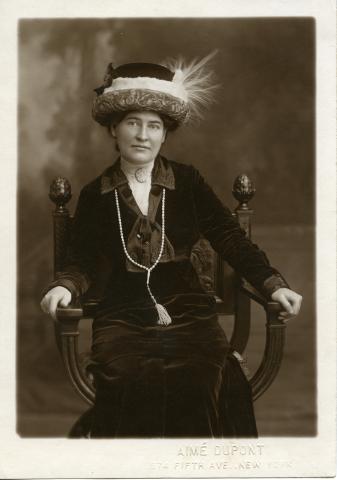
Working at McClure's launched Cather in many ways. Arriving in New York in 1906 she was soon sent to Boston to work on the magazine's biography of Mary Baker Eddy which needed checking and rewriting. There she met Sarah Orne Jewett, subsequently an important literary mentor and also Ferris Greenslet, a prominent editor at Houghton Mifflin. As a reviewer he had been impressed by April Twilights; as an editor he published Cather's first four novels and, even after she shifted publishers, he remained a lifelong friend. At McClure's, too, Cather connected with Edith Lewis, a person she knew from Lincoln who was to be her closest lifetime companion—the two took an apartment together just off Washington Square in 1908. They lived together for the rest of Cather's life and, along with McClung, Lewis would foster Cather's fiction. Because she was an editor, though, Lewis's work was that of an editorial collaborator while McClung was more of a muse. There is no question that Lewis’s work on Cather’s writing was far more than technical; much of it was literary, as Homestead has shown.
Ironically, throughout her time at McClure's, Cather struggled to break away from the magazine to write—Cather was able to finally leave full-time editorial work in early 1912. Even so, the connection was critical to Cather's development as a writer—once she had made contact with McClure he published her stories ("The Sculpter's Funeral," "Paul's Case"), but after she arrived there her contributions to the magazine—poems, fiction, nonfiction articles—increased. Even as she left McClure's Cather continued to publish there; it serialized her first novel, Alexander's Bridge, in 1912. Once she had completed her second novel (the one she called her real "first novel" since it offers her true material), O Pioneers!, Cather agreed to listen to S. S. McClure tell his own story orally; having done so, she wrote his autobiography, one ironically titled My Autobiography. It was published in 1914 and, as is now quite clear, had a major and sustained effect on Cather's narrative technique in her own fiction.
Emerging Writer, 1914-1922
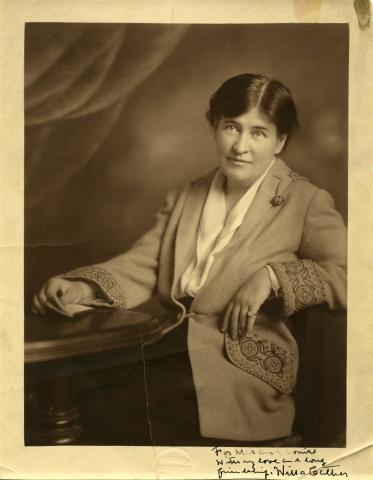
Having spent as much time as she had discovering just how literary publication happened in the United States, Cather in the early 1910s—just as she set out to "make herself born" as she would write of another artist, Thea Kronborg, in The Song of the Lark (150)—the Willa Cather who was about forty years of age was ready to do what was needed to succeed by writing unique fiction. Having taken her influences from throughout the western literary tradition—those influences are seen throughout her journalism—Cather was poised, as she would write of Virgil in My Ántonia, to "bring the Muse into [her] country" (256). She did, as is made evident by the four novels published during the 1910s. Yet, as with the effect of listening to McClure tell his story and then writing it, Cather learned to create on her pages a new-found sense of intimacy, one borne of the relation between intimates. This is first really seen in My Ántonia, a novel that takes up prairie pioneering for a second time, and tells that story in a much more affecting way because of the intimate relation Cather creates between her actual narrator, Jim Burden, and Ántonia Cuzak, "his" Ántonia.
During this time too, Cather drew on her experience as a literary journalist and editor. Her letters to various persons who were in positions able to help her career—reviewers like H. W. Boynton and H. L. Mencken, editors from her McClure's days, and especially Ferris Greenslet and others at Houghton Mifflin—reveal Cather as a person striving to achieve the literary reputation necessary to both write the ways she wanted to and to support herself financially. This struggle led, ultimately, to Cather's dissatisfaction with Houghton Mifflin's handling of My Ántonia and her decision to shift to Alfred A. Knopf as her he publisher (see Thacker "Puzzle"). Just then he was still a relatively young man just starting out, a single publisher with both strong aesthetic and business sense. In significant ways, they were a perfect pair—Knopf published Youth and the Bright Medusa, a collection containing both new stories and others revised from The Troll Garden, in 1920. It was followed by One of Ours, a watershed novel for which Cather won the Pulitzer Prize.
The Later Years, 1933-1947
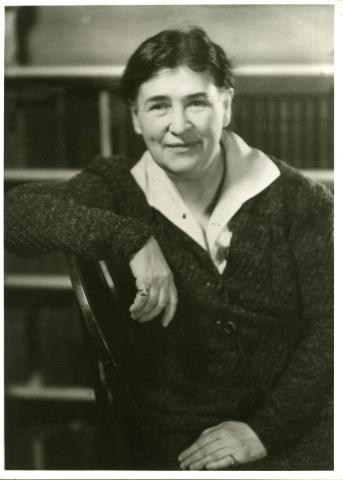
Yet not at all surprisingly Cather continued to write on those subjects that interested her—and did so complexly and brilliantly, as Skaggs argues. She inverted the circumstance and some of the characters of the early The Song of the Lark to make Lucy Gayheart—there, Lucy's talents and personal aspirations are thwarted, she returns home and dies. Yet as with The Professor's House, Cather offers a third section to her story which seems, clearly, to articulate some of what should be called the wisdom of life, of being. Along with her response to her critics with Not Under Forty, Cather prepared a multi-volume autograph edition of her works with Houghton Mifflin that, among other things, allowed her to give The Song of the Lark a major revision. But the foremost project Cather pursued during the late 1930s was the writing of Sapphira and the Slave Girl (1940), her last novel. In it, Cather returned to the place she started out from—as she wrote of it to a friend after it was published—and wove an intricate design connecting family history and fictional imagining—set in 1856 just before the Civil War, Cather creates Sapphira Dodderidge Colbert, a figure Skaggs sees as Cather's most inscrutable protagonist. A story that makes slavery’s horrors central, Sapphira revolves around the successful attempt to help secret Nancy, the enslaved girl, away from slavery to freedom in Canada. It concludes in a way reminiscent of Cather's radical insertion of "Tom Outland's Story" into The Professor's House. Cather appears as herself in a first-person reminiscence in a last chapter that describes Nancy's return to Back Creek Valley after the war, a scene the young Cather did witness herself. What is more, and finally, Cather appended a coda to the end of the text, an author's comment, so that the final words of her final novel are "Willa Cather."
While Sapphira proved to be Cather's last novel, during the 1940s she worked at another, "Hard Punishments," a story set in medieval Avignon, France, at the Palace of the Popes. Cather asked Edith Lewis to destroy the manuscript, which was well advanced, when she died; Lewis did, although a significant fragment remains in an archive. Deeply bothered by the Second World War and the death of many in her friends and family, Cather experienced moments of sadness and fatigue during these years, but as Lewis later remembered:
The last years were not years of decline, except in the physical sense; they were years, I think, of deeper vision, of a more penetrating sense of human life and human destiny. Willa Cather read and thought a great deal during those years. Her talk never lost its wonderfully incandescent quality, its vividness and fire. (186)
During these years as well Cather corresponded with E. K. Brown, a noted Canadian critic then teaching at the University of Chicago. Brown had published two laudatory essays on Cather, most recently "Homage to Willa Cather" in the Yale Review. The two planned a meeting and, had it happened, there is every reason to suppose that Cather would have cooperated with him on the first biography. He did come to write it, but without ever meeting Cather.
On April 24, 1947, Cather died from cancer. A private funeral was held in New York, and a memorial service was conducted at Grace Episcopal Church in Red Cloud, the church which Cather and her parents had joined in late 1922. Cather was buried in the Old Burying Ground in Jaffrey Center, New Hampshire. Engraved on her tombstone along with her name and incorrect birth date—she had long listed 1876 as her birth year—is this quotation from My Antonia: "that is happiness, to be dissolved into something complete and great" (18). Complex and brilliant indeed, Willa Cather lives on through her manifold readers.
Works Cited
Acocella, Joan. Willa Cather and the Politics of Criticism. Lincoln: U of Nebraska P, 2000.
Bohlke, Brent L. Willa Cather in Person: Interviews, Speeches, and Letters.
Lincoln: U of Nebraska P, 1986.
Brown, E. K. "Homage to Willa Cather." Yale Review 36 (1946): 77-92.
Cather, Willa. Lucy Gayheart. New York: Knopf, 1935.
---. My Ántonia. 1918. Willa Cather Scholarly Edition. Ed. Charles W. Mignon and
James Woodress. Lincoln: U of Nebraska P, 1994.
---. Not Under Forty. New York: Knopf, 1936.
---. The Song of the Lark. 1915. Ed. Sherrill Harbison. New York: Penguin, 1999.
Hicks, Granville. "The Case Against Willa Cather." 1933. Willa Cather and
Her Critics. Ed. James Schroeter. Ithaca: Cornell UP, 1967. 139-47.
Homestead, Melissa J. The Only Wonderful Things: The Creative Partnership of Willa Cather and Edith Lewis. New York: Oxford, 2021.
Lewis, Edith. Willa Cather Living: A Personal Record. 1953. Introd. John J.
Murphy. Lincoln: U of Nebraska P, 2000.
O'Brien, Sharon. Willa Cather: The Emerging Voice. New York: Oxford, 1987.
Remnick, David. "Postscript: Philip Roth." New Yorker June 4, 2018: 44.
Rosowski, Susan J. "Recent Books on Willa Cather: An Essay Review." Modern
Fiction Studies 36 (1990): 131-41.
Skaggs, Merrill Maguire. After the World Broke in Two: The Later
Novels of Willa Cather. Charlottesville: UP of Virginia, 1990.
Stout, Janis P. Cather Among the Moderns. Tuscaloosa: U of Alabama Press, 2019.
Thacker, Robert. "‘It's Through Myself that I Knew and Felt Her': S. S.
McClure's My Autobiography and the Development of Willa Cather's
Autobiographical Realism." American Literary Realism 33 (2001): 123-42.
---. "She's Not a Puzzle So Arbitrarily Solved: Willa Cather's Violent Self-Construction."
Violence, the Arts, and Willa Cather. Ed. Joesph R. Urgo and Merrill Maguire
Skaggs. Madison, NJ: Fairleigh Dickinson UP, 2007. 124-36.
Woodress, James. Willa Cather: A Literary Life. Lincoln: U of Nebraska P, 1987.
About the Contributor: Robert Thacker

Robert Thacker is Charles A. Dana Professor of Canadian Studies and English Emeritus at St. Lawrence University. He has published extensively on Alice Munro, Cather, the Prairie West, and Canada-U.S. literary comparisons. His books include The Great Prairie Fact and Literary Imagination (1989), the biography, Alice Munro: Writing Her Lives (2005; revised 2011), and Alice Munro’s Late Style: “Writing is the Final Thing” (2023). He edited Cather's April Twilights and Other Poems (2013) and coedited Willa Cather's Canadian and Old World Connections (Cather Studies 4, 1999), Willa Cather: A Writer's Worlds (Cather Studies 8, 2009), and Willa Cather at the Modernist Crux (Cather Studies 11, 2017). He was codirector of three International Cather Seminars (Quebec City, 1995; France, 2007; Flagstaff, Arizona, 2013) and is now editing the scholarly edition of Cather’s Complete Poems.

